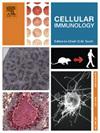槲皮素通过靶向NLRC5/NLRP3通路抑制M1巨噬细胞极化,缓解糖尿病肾病
IF 2.9
4区 医学
Q2 CELL BIOLOGY
引用次数: 0
摘要
M1/M2巨噬细胞表型的激活失衡在糖尿病肾病(DN)中至关重要。本研究旨在探讨槲皮素抗DN的分子机制。方法在体外用槲皮素或不加槲皮素培养高糖(HG)巨噬细胞。研究了NLRC5的过表达以阐明其机制。采用细胞表面标志物CD86和CD206,流式细胞术评估M1/M2巨噬细胞分化情况。在体内,采用高脂肪饮食和链脲佐菌素(STZ)建立DN小鼠模型。槲皮素分别以50 mg/kg和100 mg/kg剂量灌胃DN小鼠。安乐死后,用苏木精和伊红(H&;E)、马松三色和免疫组织化学(IHC)染色对小鼠肾脏进行分析。ELISA法和western blot法检测相关分子水平。结果槲皮素在体外显著降低hg诱导的巨噬细胞CD86、iNOS、NLRC5、NLRP3和促炎细胞因子(TNF-α、IL-6、IL-1β)的表达,升高hg诱导的RAW 264.7巨噬细胞CD206、Arg-1和IL-10的表达。然而,当NLRC5过表达时,槲皮素的这些作用被消除。在DN小鼠中,槲皮素可改善肾组织病理学损伤和纤维化。值得注意的是,NLRC5、NLRP3、Col1a1和α-SMA的表达显著降低,同时促炎细胞因子(TNF-α、IL-6和IL-1β)的表达降低。结论槲皮素通过靶向NLRC5/NLRP3通路抑制m1型巨噬细胞改善DN。本文章由计算机程序翻译,如有差异,请以英文原文为准。
Quercetin alleviates diabetic nephropathy by inhibiting M1 macrophage polarization via targeting NLRC5/NLRP3 pathway
Background
The activation imbalance of M1/M2 macrophage phenotypes is crucial in diabetic nephropathy (DN). This study aimed to explore the molecular mechanisms underlying quercetin's action against DN.
Methods
In vitro, RAW 264.7 macrophages were incubated with high glucose (HG) with or without quercetin. Overexpression of NLRC5 was investigated to elucidate the mechanism. M1/M2 macrophage differentiation was assessed by flow cytometry using cell surface markers CD86 and CD206. In vivo, a DN mouse model was created using a high-fat diet and streptozotocin (STZ). Quercetin was administered intragastrically to DN mice at 50 mg/kg and 100 mg/kg. After euthanasia, mouse kidneys were analyzed by hematoxylin and eosin (H&E), Masson's trichrome, and immunohistochemistry (IHC) staining. ELISA assay and western blot analysis were performed to determine related molecular levels.
Results
In vitro, quercetin significantly reduced HG-induced expressions of CD86, iNOS, NLRC5, NLRP3, and pro-inflammatory cytokines (TNF-α, IL-6, IL-1β), while increasing HG-induced CD206, Arg-1, and IL-10 in RAW 264.7 macrophages. However, these effects of quercetin were abolished when NLRC5 was overexpressed. In DN mice, quercetin administration ameliorated renal histopathological injury and fibrosis. Notably, there was a significant reduction in expressions of NLRC5, NLRP3, Col1a1, and α-SMA, along with decreased expressions of pro-inflammatory cytokines (TNF-α, IL-6, and IL-1β).
Conclusion
This study showed that quercetin improves DN by inhibiting M1-type macrophages through targeting the NLRC5/NLRP3 pathway.
求助全文
通过发布文献求助,成功后即可免费获取论文全文。
去求助
来源期刊

Cellular immunology
生物-免疫学
CiteScore
8.20
自引率
2.30%
发文量
102
审稿时长
30 days
期刊介绍:
Cellular Immunology publishes original investigations concerned with the immunological activities of cells in experimental or clinical situations. The scope of the journal encompasses the broad area of in vitro and in vivo studies of cellular immune responses. Purely clinical descriptive studies are not considered.
Research Areas include:
• Antigen receptor sites
• Autoimmunity
• Delayed-type hypersensitivity or cellular immunity
• Immunologic deficiency states and their reconstitution
• Immunologic surveillance and tumor immunity
• Immunomodulation
• Immunotherapy
• Lymphokines and cytokines
• Nonantibody immunity
• Parasite immunology
• Resistance to intracellular microbial and viral infection
• Thymus and lymphocyte immunobiology
• Transplantation immunology
• Tumor immunity.
 求助内容:
求助内容: 应助结果提醒方式:
应助结果提醒方式:


